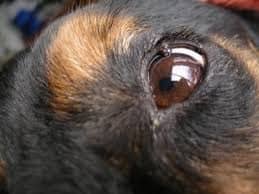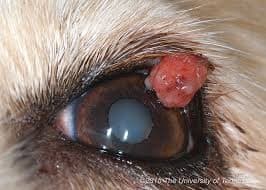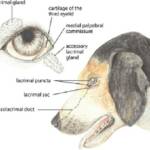Many eyelid tumors in dogs are overgrowth of the meibomian gland. These tumors are tiny, slow-growing tumors that form in the meibomian glands of the eyelids. (Meibomian glands are sebaceous glands that provide an oily secretion to stabilize the tear film over the cornea.) Common in older dogs, meibomian gland tumors are usually benign, but a small percentage of them are carcinomas that can metastasize into lymph nodes.
Meibomian gland tumors can protrude outward or can extend into the eyelid. Some of these tumors will become ulcerated. Some will cause keratoconjunctivitis (an inflammation of the cornea and conjunctiva). Benign tumors generally do not spread, but they can become inflamed, irritated, and painful. If the tumor becomes large enough, it can cause problems during blinking (resulting in extra tearing and tear staining). Most meibomian gland tumors grow slowly. A veterinarian can detect them easily because of where the tumors are located – basically, they are visible during examination.

Treating the Tumor with Surgery and Cryosurgery
Many of these tumors can be completely removed with surgery. If the tumor isn’t completely removed, it may continue to grow. If the tumors are very small, there is a chance that a sedative and local anesthesia will be enough, that is assuming your dog is very patient and will sit still with someone working near the eye. With wiggly pets or larger masses, general anesthesia will be required. Cryosurgery (tissue freezing) may also be used to remove the tumor.
After the tumor is removed, you may see a bit of blood in the dog’s tears for a couple of days. The surgical site will be swollen for a week or so. Within two weeks, the surgery site will probably turn pink, and the hairs around the site may become white. Generally speaking, the skin will become repigmented within a few months, but the white hair will remain permanently.

Less than 10 percent of these eyelid tumors recur. If they do come back, they will usually be seen within six months or so. Check the eyelids often to find new and recurring tumors.


